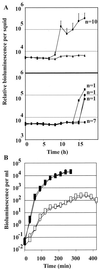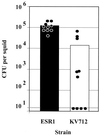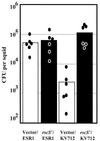Two-component sensor required for normal symbiotic colonization of euprymna scolopes by Vibrio fischeri
- PMID: 11208780
- PMCID: PMC94949
- DOI: 10.1128/JB.183.3.835-842.2001
Two-component sensor required for normal symbiotic colonization of euprymna scolopes by Vibrio fischeri
Abstract
The light organ of the squid Euprymna scolopes is specifically colonized to a high density by the marine bacterium Vibrio fischeri. To date, only a few factors contributing to the specificity of this symbiosis have been identified. Using a genetic screen for random transposon mutants defective in initiating the symbiotic association or in colonizing the light organ to high density, we identified a mutant of V. fischeri that exhibited an apparent defect in symbiosis initiation. This mutant was not defective in motility, luminescence, or growth in minimal medium, suggesting that it lacks an essential, previously unidentified symbiotic function. By sequence analysis, we showed that the locus inactivated in this mutant encodes a predicted 927-amino-acid protein with a high degree of similarity to the sensor component of hybrid two-component regulatory systems. We have therefore designated this locus rscS, for regulator of symbiotic colonization-sensor. Sequence analysis revealed two hydrophobic regions which may result in the formation of a periplasmic loop involved in signal recognition; PhoA fusion data supported this proposed membrane topology. We have investigated the start site of rscS transcription by primer extension and identified a putative promoter region. We hypothesize that RscS recognizes a signal associated with the light organ environment and responds by stimulating a putative response regulator that controls protein function or gene expression to coordinate early colonization events. Further studies on RscS, its cognate response regulator, and the signaling conditions will provide important insight into the interaction between V. fischeri and E. scolopes.
Figures





Similar articles
-
Role for phosphoglucomutase in Vibrio fischeri-Euprymna scolopes symbiosis.J Bacteriol. 2002 Sep;184(18):5121-9. doi: 10.1128/JB.184.18.5121-5129.2002. J Bacteriol. 2002. PMID: 12193629 Free PMC article.
-
FlrA, a sigma54-dependent transcriptional activator in Vibrio fischeri, is required for motility and symbiotic light-organ colonization.J Bacteriol. 2003 Jun;185(12):3547-57. doi: 10.1128/JB.185.12.3547-3557.2003. J Bacteriol. 2003. PMID: 12775692 Free PMC article.
-
GacA regulates symbiotic colonization traits of Vibrio fischeri and facilitates a beneficial association with an animal host.J Bacteriol. 2003 Dec;185(24):7202-12. doi: 10.1128/JB.185.24.7202-7212.2003. J Bacteriol. 2003. PMID: 14645281 Free PMC article.
-
An intricate network of regulators controls biofilm formation and colonization by Vibrio fischeri.Mol Microbiol. 2009 Nov;74(4):782-9. doi: 10.1111/j.1365-2958.2009.06899.x. Epub 2009 Oct 8. Mol Microbiol. 2009. PMID: 19818022 Free PMC article. Review.
-
Lessons from a cooperative, bacterial-animal association: the Vibrio fischeri-Euprymna scolopes light organ symbiosis.Annu Rev Microbiol. 1996;50:591-624. doi: 10.1146/annurev.micro.50.1.591. Annu Rev Microbiol. 1996. PMID: 8905092 Review.
Cited by
-
Vibrio fischeri Biofilm Formation Prevented by a Trio of Regulators.Appl Environ Microbiol. 2018 Sep 17;84(19):e01257-18. doi: 10.1128/AEM.01257-18. Print 2018 Oct 1. Appl Environ Microbiol. 2018. PMID: 30030225 Free PMC article.
-
Discovery of Calcium as a Biofilm-Promoting Signal for Vibrio fischeri Reveals New Phenotypes and Underlying Regulatory Complexity.J Bacteriol. 2018 Jul 10;200(15):e00016-18. doi: 10.1128/JB.00016-18. Print 2018 Aug 1. J Bacteriol. 2018. PMID: 29463601 Free PMC article.
-
Tools for Rapid Genetic Engineering of Vibrio fischeri.Appl Environ Microbiol. 2018 Jul 2;84(14):e00850-18. doi: 10.1128/AEM.00850-18. Print 2018 Jul 15. Appl Environ Microbiol. 2018. PMID: 29776924 Free PMC article.
-
CpxRA regulates mutualism and pathogenesis in Xenorhabdus nematophila.Appl Environ Microbiol. 2007 Dec;73(24):7826-36. doi: 10.1128/AEM.01586-07. Epub 2007 Oct 19. Appl Environ Microbiol. 2007. PMID: 17951441 Free PMC article.
-
Identification of Aeromonas veronii genes required for colonization of the medicinal leech, Hirudo verbana.J Bacteriol. 2007 Oct;189(19):6763-72. doi: 10.1128/JB.00685-07. Epub 2007 Jul 6. J Bacteriol. 2007. PMID: 17616592 Free PMC article.
References
-
- Alexeyev M F, Shokolenko I N. Mini-Tn10 transposon derivatives for insertion mutagenesis and gene delivery into the chromosome of Gram-negative bacteria. Gene. 1995;160:59–62. - PubMed
-
- Appleby J L, Parkinson J S, Bourret R B. Signal transduction via the multi-step phosphorelay: not necessarily a road less traveled. Cell. 1996;86:845–848. - PubMed
-
- Arico B, Scarlato V, Monack D M, Falkow S, Rappuoli R. Structural and genetic analysis of the bvg locus in Bordetella species. Mol Microbiol. 1991;5:2481–2491. - PubMed
Publication types
MeSH terms
Substances
Associated data
- Actions
Grants and funding
LinkOut - more resources
Full Text Sources

